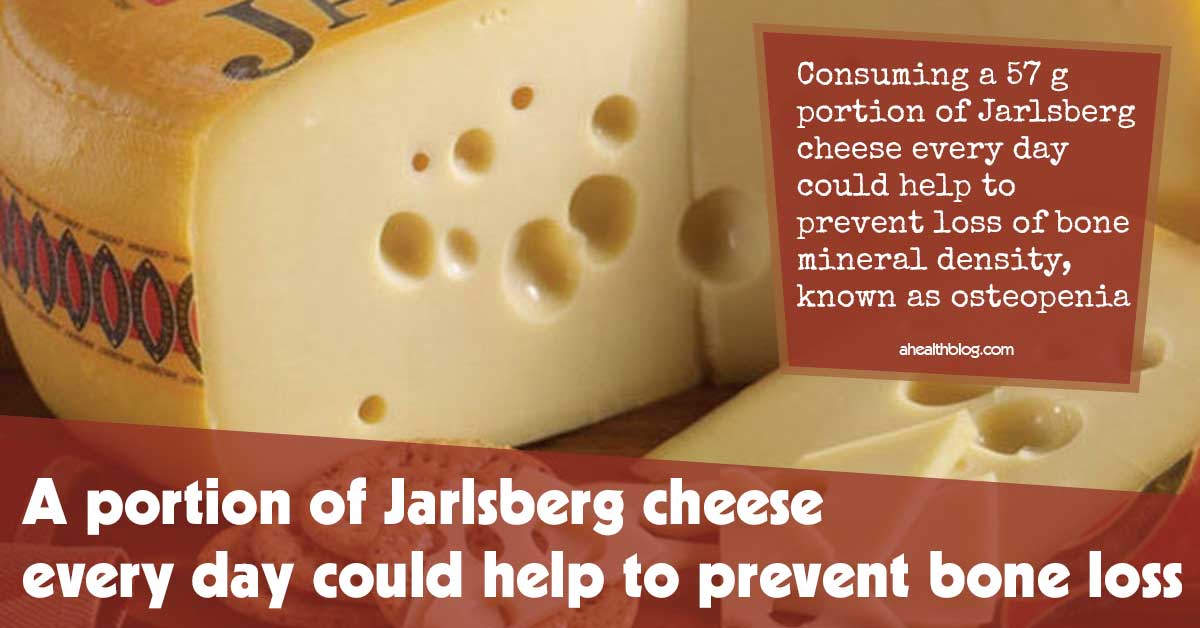The results of a study suggest that consuming a 57 g portion of Jarlsberg cheese every day could help to prevent loss of bone mineral density, known as osteopenia, without increasing detrimental LDL cholesterol. The study results show that the effects appear to be unique to this kind of cheese.1✅ JOURNAL REFERENCE
DOI: 10.1135/bmjnph-2022-000424
Jarlsberg is a semi-soft, mild, and nutty flavored cheese produced from cow’s milk, and comes from a town in eastern Norway called Jarlsberg.
Prior research suggests that it could help increase osteocalcin levels, a hormone that’s linked to strong teeth and bones, but it’s unclear if this effect is unique to Jarlsberg or other kinds of cheese.
For the study, the researchers recruited 66 healthy women with an average age of 33, and a BMI of 24 on average, who were randomly assigned to include either a 50 g of Camembert or 57 g portion of Jarlsberg cheese in their diet every day for 6 weeks.
At the end of the 6 weeks, the group consuming Camembert changed over to Jarlsberg for an additional 6 weeks.
Camembert and Jarlsberg have similar protein and fat contents, but Jarlsberg is an abundant source of vitamin K2, also called menaquinone.
There are a number of varieties of menaquinone, animal products which include liver contain the short-chained MK-4 menaquinone. The long-chained MK-7 menaquinone, MK-8 menaquinone, MK-9 menaquinone, and MK-9(4H) menaquinone come from bacteria and can be found in some fermented foods, which include cheese. Jarlsberg is especially abundant in MK-9 menaquinone as well as MK-9(4H) menaquinone.
Blood samples were obtained from the individuals participating in the study every 6 weeks to measure for osteocalcin, key proteins, and a peptide involved in the turnover of bone known as PINP. Levels of blood fat and vitamin K2 were also checked.
An analysis of blood samples revealed that vitamin K2 and the main biochemical bone turnover markers, which included osteocalcin, increased noticeably in the group consuming Jarlsberg after 6 weeks.
PINP levels stayed unchanged in the group consuming Camembert while there was a slight decrease in levels of the other biochemical markers. They however increased substantially after changing to Jarlsberg. Levels of PINP also increased.
After 6 weeks, there was a slight increase in blood fats in both groups. But total cholesterol and LDL cholesterol levels decreased substantially in the group consuming Camembert after changing to Jarlsberg.
Glucose levels stuck in red blood cells known as HbA1c increased by 2% in individuals consuming Camembert and decreased by 3% in the group consuming Jarlsberg. But after changing to Jarlsberg HbA1c decreased in the group consuming Camembert as well.
Magnesium and calcium decreased in the group consuming Jarlsberg but stayed unchanged in the Camembert group. Calcium levels decreased in the group consuming Camembert as well after changing to Jarlsberg cheese, which could be a result of increased uptake of these important bone formation minerals.
Consumption of Jarlsberg cheese every day positively affected osteocalcin, other bone turnover markers, lipids, and HbA1c.
The bacteria in Jarlsberg known as proprionebacterium freudenreichii that produces MK-9-(4H) menaquinone also produces a substance known as DHNA, which research indicates could help prevent the thinning of bone and increase the formation of bone tissue, and possibly explain the osteocalcin increase.
The researchers suggest that Jarlsberg cheese could therefore help in preventing osteopenia, the stage preceding osteoporosis, in addition to metabolic diseases, which include diabetes.
The researchers however caution that because this was a small study in healthy and young individuals developed to explore pathways associating bone health and diet, and the results should be interpreted with caution as the individuals who participated in the study will not necessarily represent other population groups. The study results should also not be regarded as a recommendation to consume a particular kind of cheese.




